(7) ARACHNIDA - ORDER I: ACARIDEA - GENERAL OBSERVATIONS
GENERAL OBSERVATIONS. - Acaridians are universally distributed; they are to be found under stones, dead leaves, or bark of trees, in the ground, in water, in unrefined sugar, upon dried meat, fruits, cheese, and putrid animal matters, upon all of which they feed. Some are parasitic, both externally and internally, in the flesh of different animals, living upon the juices of the creatures they infest. One species, Sarcoptes Scabiei, is the cause of the disease called the "itch"; another is our troublesome "Harvest-bug." Some are parasitic upon insects of different kinds; others are said to have been found in the brain and eyes of man. All are small, great numbers almost microscopic; the smaller kinds, particularly of the Acarides, are very difficult to preserve as cabinet objects, and from this, as well as from their minuteness, the order, generally, does not receive that attention to which, from their diversified forms and modes of life, Acaridian are certainly entitled.
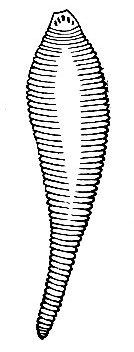
Fig. 1-- Pentastoma ___oides, Rud.
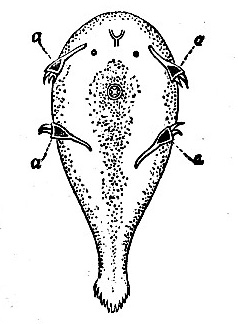
Fig. 2 -- The same in the immature form; under sidem a...a, legs.
From various considerations of structure, the Acaridea may be divided into ten families, each containing one or more genera. These families may shortly be characterized as follows: -
Fam.1. Pentastomides. - Body annulate, vermiform, lancet-shaped; the segments of the cephalo-thorax continuous with the body, and furnished with four strong claws or rudimentary legs; this appears (Rolleston, Forms of Animal Life, p. 118) to be the larva or immature state, the adult form being destitute of limbs (which are replaced by four hooks - two on each side of the mouth), and reversing the ordinary progress of many acarids, from a fewer to a larger number of legs; organs of respration and circulation, none (Huxley). On this abnormal family, of which one genus and eighteen species have been described, see Cobbold's Entozoa, pp. 393-402, and authorities there quoted. (See figs. 1,2.)
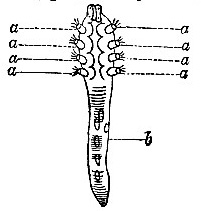
Fig. 3 -- Demodex folliculorum, Simon: under side, a...a, rudimentary legs; b, abdomen.
Fam. 2. Tanurides ( tanaos (Gk), long, oura (Gk), a tail). - The type of this family is Demodex folliculorum, Simon (fig. 3), a very curious parasite found in the follicles of the human nose-hence its specific name. It is long and slender; the abdomen drawn out into a wormlike tail; the fore part or cephalo-thorax has in the adult state four pairs of rudimentary legs, in the immature state three pairs. This is one of the lowest forms of acaridians, and presents in its adult state the immature vermiform appearance of the higher genus Typhlodromus (Packard, l.c.)
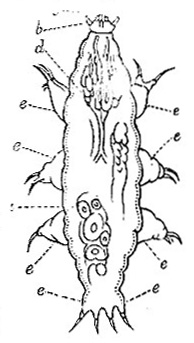
Fig. 4 -- Milnesium tardigradum, Schrank. a, ovary; b, palpi (?); c, parts of mouth; d, alimentary canal; e...e, legs (rudimentary)
Fam. 3. Tardigradides. - Body cylindrical, vermiform, but with no distinct abdomen; it is furnished throughout its whole length with four pairs of rudimentary limbs, of which the fourth pair is quite at the posterior extremity, eyes, two; falces, style-like. These animals are microscopic in size and aquatic in habits; they are hermaphrodite, and are generally held to be acarids of a very low grade (Packard, l.c. p. 668). Several genera have been characterized. Fig. 4 represent Milnesium tardigradum, Schrank.
Fam. 4. Acarides. - We now come to the more typical froms of Acaridea. The family Acarides have a soft, thin-skinned body, with the thoracic junction often visible; falces either scissor-like or styliform; maxillae obsolete; legs of the two first pairs often widely distant from those of the hinder ones; in some lowly organized forms, "face-mites," four legs only are found; perhaps these are the immature form of some other species (?); eyes, none. in this family are included the cheese, itch, and sugar mites, with numerous others parasitic on various animals. Some forms, as Heteropus ventricosus (Newport), Dermaleichus, and Typhlodromus, particularly in the immature state , exhibit an evident link between the last two families and the higher acarids; on the agamic reproduction of a species of this family (Cheyletus) see r. Beck in Q.J. Microsc. Sc., April 1866; also Newman's Zoologist, 2 ser., i. p 236.
Fam. 5. Oribatides. - Body hard and horny; the thoracic junctions visible; form of the abdomen, round, globular, oval, quadrangular, or hemispherical; palpi, short; maxillae, large and toothed; eyes, almost obsolete; cephaloi-thorac, generally with two wing like projections and two or three cup-shaped pedicellated stigamata on the edge, leading to the respiratory tubes. The Oribatides in general live on vegetable matter, and several genera have been characterized. The immature forms of many species vary greatly from the adults,s so that numbers have been described as distinct species. See on this family an elaborate paper by M.H. Nicolet, in the Arch. Du Mus. T. vii pp. 383-382, pls. 24-33.
Fam. 6. Gamasides. - Body, oval, flattened; epidermis, dense; falces, scissors-like; maxillae, free; legs, equal in size and of similar form; eyes, obsolete. There are several genera of this family parasitic on various animals.
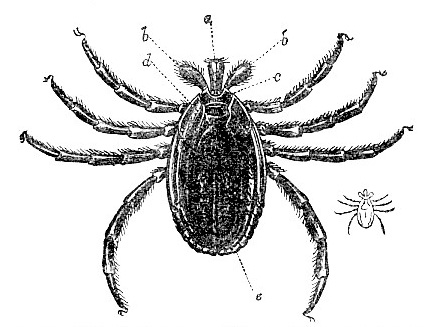
Fig. 5 -- Ixodes aegyptus, Savigny. a, falces; b, b, palpi; c, caput; d, cephalothorax; e, abdomen.
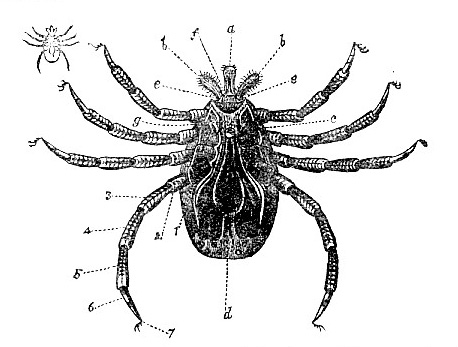
Fig. 6 -- The same, under side. a, falces; b, b, palpi; c, genital aperture; d, anal orifice; e,e,f, maxillae and labium soldered together; g, sternum.
Fam. 7. Ixodides. - Body, round, oval, or somewhat a oblong, of a keathery consistency; palpi, short, three or four jointed; falces, saw-like, and, with the other parts of the mouth, joining in the formation of a beak for thrusting into and holding on to their prey. Eyes, often obsolete; legs weak. On the generation of Ixodes, see a paper by prof. Gene, communicated by A. Tulk to Ann, and Mag. N.H. No. 188, Sept. 1846, p. 160. When gorged with the juices of their victim the abdomen attains an enormous size, and appears almost to obliterate all the rest of the body. In this family are comprised the "ticks" (Ixodes), which are often so tormenting to mankind, and domestic and other animals (figs. 5,6). Among these ticks is included also the noted genus Argas, of which a species, A. reflexus (latr.) has lately bees found at Canterbury, England. Some of the largest known acarids are contained in this family.
Fam. 8. Hydrachnides, or water-mites. Body, oval or almost globular; palpi, short; legs, ciliated for the purpose of swimming; eyes, two. These acarids are found in salt as well as in fresh water. Some are parasitic, when immature, on water-bugs and water-beetles; others, through, life, on the gills of the fresh-water mussel.
Fam. 9 Tombidides. - Body, stout , round, or oval, and often somewhat oblong; frequently broader before than behind; sometimes clothed densely with a kind of pubescence. The two hinder
Fam. 10. Bdellides. - Body, oblong-oval, showing the junctions of caput, thorax, and abdomen, palpi, long; eyes, two to six, sometimes obsolete; legs, long and strong; parts of the mouth forming a tapering pointed beak of greater or less length, and looking like a prolongation of the caput. The Bdellides live in damp places, under moss, &c., and on the floors of caverns.
The above characters of the Acaridian families are abridged chiefly from A.S. Packard's Guide to the Study of Insects. Besides Claparède's Studien an Acariden, and Nicolet's Mémoire on Oribatides, and other works above noted, may be mentioned Dr C. Heller on the anatomy of Argas persicus, Sitzungsb d. K. Akad.d. W. Math naturw. Cl xxx. No. 16, 1858, pp. 297-326, Taf. I.-iv.; Charles Robin's Mémoire zoologique et anatomique sur diverses espèces d'Acariens de la Famille des Sarcoptes, 1860, with 8 plates; also by same author, "Mémoire sur les Sarcoptes avicoles, et sur les metamorphoses des Acariens," Comptes Rendus, tom. lxvi. Pp. 776-786; H.A. Pagenstecker, Beiträge zur Anatomie der Milben, Haft 1, "Trombidium," 2 taf. 32. pp., Leipsic, W. Engelman, 1860; P. J. van Beneden, "Recherches sur l'histoire naturelle et la développement de l'Atax Ypsilophorus (Hydrachna concharum)," Nouv. Mém. De l'Acad. De Belge, tom. xxiv. 1850 (24 pp. ed. 1 pl.) Of the older works on Acaricea may be mentioned that of Hermann, Mémoire Apterologique, in fol., Strasboug, 1804; and P. Gervais, in Walckenaer's Ins. Apt., tom. iii. pp. 132-288, pls. 31-36 and 38, 1844; Doyere, "Mémoire sur les Tardigrades," Ann. Sc. Nat. 2 ser. "Zool., "tom. xiv. 1840, pp. 269-361; suite, Ibid., tom. xvii. 1842, pp. 193-205, and tom. xviii. 1842, pp. 5-35, with 8 plates: P.J. van Beneden, "Recherchessur l'organization et de la développement des Linguatules (Pentastome, Rud.) suivies," &c., 39 pp. with 1 pl., in Nouv. Mém. De l'Acad. De Belge, tom. xxiii. 1849.
Read the rest of this article:
Arachnida - Table of Contents
|





